
GLENN LONEY'S SHOW NOTES
By Glenn Loney, July 27, 2000
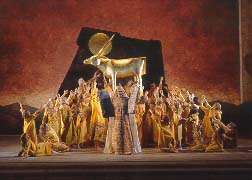
| |
| MOSES CONFRONTS GOLDEN CALF--Old Testament "Living Picture" in newly designed Oberammergau Passion Play. Photo: Brigitte Maria Mayer/©Oberammergau 2000. | |
[02] Robert Wilson's "Stations of the Cross"
You can use your browser's "find" function to skip to articles on any of these topics instead of scrolling down. Click the "FIND" button or drop down the "EDIT" menu and choose "FIND."
How to contact Glenn Loney: Please email invitations and personal correspondences to Mr. Loney via Editor, New York Theatre Wire. Do not send faxes regarding such matters to The Everett Collection, which is only responsible for making Loney's INFOTOGRAPHY photo-images available for commercial and editorial uses.
How to purchase rights to photos by Glenn Loney: For editorial and commercial uses of the Glenn Loney INFOTOGRAPHY/ArtsArchive of international photo-images, contact THE EVERETT COLLECTION, 104 West 27th Street, NYC 10010. Phone: 212-255-8610/FAX: 212-255-8612.
A New Look for Oberammergau:
Passion Play 2000 With New Sets & Costumes
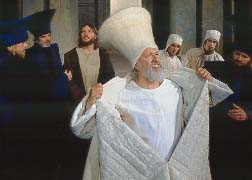
| |
| MAKING A CLEAN BREAST OF IT ALL--Impressive new costumes for historic Oberammergau Passion Play. Photo: Brigitte Maria Mayer/©Oberammergau 2000. | |
Unfortunately, Oberammergau and the rest of Germany suddenly come under Nazi dictatorial rule in 1933. The Nazi ruling clique was—privately at least—opposed to orthodox religions.
But, amazingly enough, the Führer, Adolf Hitler, admired the famous centuries-old Oberammergau drama of Jesus Christ's last days on earth. He is reported to have viewed it as an authentic Aryan example of native peasant art and culture.
So he approved of the special 300-year Jubilee performances in 1934. These were the last until 1950, for Germany was at war in 1940. Although the sacred play is traditionally only performed at the beginning of each decade, there was another Jubilee in 1984—the 350th.
After World War II and Germany's defeat, the Nazi approbation and charges of anti-semitism by Jewish leaders posed problems for its revival.
Even American playwright Arthur Miller—as well as Elie Wiesel and other Jewish activists—has signed letters of protest about the text of the play and the way it has been performed in recent decades. Portrayals of the High Priest and members of the Jewish Sanhedrin—in text and in performance—have been denounced as anti-semitic stereotypes.
Beginning with the 1960 performances—when the Passion Play was still eight hours long—local attempts were made to overcome such objections. Pater Stefan, of nearby Kloster Ettal, had even written a new version, designed to remove the taint of anti-semitism. I went to the monastery to talk with him about it and read the text.
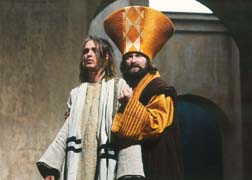
| |
| POOR VERSUS RICH--Strong design contrasts between followers of Jesus and leaders of Orthodoxy in Oberammergau Passion Play. Photo: Tomas Dashuber/©Oberammergau 2000. | |
But the Gospels do indict the High Priest, the Sanhedrin, and the ruling clique in Jerusalem for demanding Jesus' arrest, trial, and death. And for inciting common people to echo their demands in the streets of the Holy City.
Nonetheless, it is also quite clear in the Gospels that Jesus and his followers were all Jews themselves. They certainly weren't Christians, as the term came to be understood.
Recent biblical scholarship has even suggested that Jesus may have been a Zealot, the militant group that hoped to drive the Romans out of Judea and recover their homeland. Jesus' violent driving the money-changers out of the sacred precincts of the Temple could have been the act of a Zealot.
Both Jesus and the Zealots were appalled by rampant corruption in high places and the profanation of their sacred beliefs. This automatically made Him a danger to the priests, merchants, and politicians collaborating with the Roman overlords.
Their fears concerned loss of power, influence, and luxury. Worse, the belief of many ordinary Jews that Jesus was the long-promised Messiah could give Him the support needed to make him actually the earthly king and defender of the Jews.
That, according to the New Testament, is why King Herod slaughtered all the innocent babies, trying to ensure that no newly-born Messiah could ever unseat him. But, in His teachings, Jesus never indicated an interest in earthly power: "My Kingdom is not of this world."

| |
| THE BIGGER THE HAT, THE WISER THE MAN--Appearances can be deceiving Oberammergau's new costumes suggest. Photo: Tomas Dashuber/©Oberammergau 2000. | |
Nor was Jesus the First Christian. He was essentially a Reform Rabbi.
In 1960, the pious citizens of Oberammergau should have renamed their historic religious drama: The Death of a Reform Rabbi. Arthur Miller might have understood and appreciated that title.
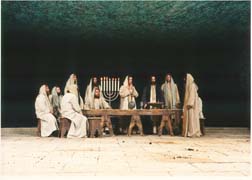
| |
| JESUS' LAST PASSOVER--Sorrowful Seder with disciples and menorah in Oberammergau Passion Play. Photo: Tomas Dashuber/©Oberammergau 2000. | |
Christmas is coming, and there will be a brisk trade in the beautiful hand-carved manger-scenes, angels, and other traditional religious images for which the town has been known for centuries.
It will be 2010 before audiences can again see the historic Oberammergau Passion Play—with its new sets and costumes. By then, they won't be so new. But the stunning costumes and the renewed multi-area stage will at least be on display to tourists in the Bavarian Alps during the nine long years before the biblical drama is repeated.
The play—based on Bible accounts of the last five days of Jesus' life—was first performed in 1634, as a village vow of thanks for being spared from the Black Plague. Since then, it has been staged with a cast of hundreds of local citizens only every decade.
In 1960, many spectators found the eight-hour running-time more of a penance than a revelation. In 1970, the playing-time was reduced to five hours.
Now director Christian Stückl has reworked the drama and added an hour to its running-time. What's more important, he has sought to present Jesus and his followers as poor but pious Jews. Not as the First Christians, dressed in handsome robes.
Local designer Stefan Hageneier, working with 12 town seamstresses, has created almost 2,000 costumes for the 18 principals and some 1,540 Oberammergau men, women, and children.
Pontius Pilate, his aides, and his Roman soldiers are dressed in armor and rich red and white fabrics. They represent the powers of Imperial Rome, as often depicted in historical paintings.
Previous costumes for the Jews—especially for the Temple High Priest and his followers—had been based on medieval artworks. Hageneier—a native of Oberammergau, who also designs for major German theatres—decided it was time for a new look.

| |
| HIGH PRIEST CAIPHAS INFLAMES SANHEDRIN--Denouncing Jesus before Council of Elders in Oberammergau Passion Play. Photo: Brigitte Maria Mayer/©Oberammergau 2000. | |
Stückl—who, like Hageneier, also works in important German theatres—tried some changes when he first staged the Passion Play for Oberammergau in 1990. Then there was a lot of resistance to his ideas, but he says: "I've won their confidence now."
In an important scene, the High Priest, dressed completely in white, complete with a huge white hat, makes a grand entry. He's sitting in a chair borne aloft by lackeys. Designer Hageneier was not about to make him a "black-hat" villain.
Stückl says he's amazed that he's received letters complaining that this costuming and staging mocks the Pope. But the Pope does appear in St. Peter's in white, borne above the faithful on a throne. The visual similarity is there, and it may be intentional.
Christian Stückl has been intent on subtly underscoring the sincere religious belief—and poverty—of the Jewish people, as opposed to the luxury, greed, and abuse of power by those over them, both Jewish and Roman.
Considering the current power, influence, and apparent wealth of the Vatican—especially in this Holy Year—Stückl may be visually, but subliminally, suggesting a parallel to the biblical pomp & circumstance recorded in the Gospels.
The agonies of Jesus after he has been betrayed and arrested are not down-played in Stückl's staging. The Crown of Thorns is woven of really thorny briars. But the blood is stage-blood.
After Roman soldiers have nailed Jesus to his cross, he hangs there for some 20 minutes, before being lowered with a long white cloth. The harness which holds him aloft is concealed in his loincloth.
For the Millennial production, the 4,700-seat covered auditorium—open at one end—was renovated for $7.5 million. The permanent stage structures were also resurfaced. They include a large proscenium stage-house at the center of the very wide stage and two smaller semi-stages at either side, linked by large arches revealing streets of Old Jerusalem.
Hageneier designed new tableaux vivants for the proscenium space. Traditionally, these living-pictures present frozen moments from the Old Testament and from Jesus' earlier life. The sets for each of these posed scenes were colorful and abstract, painted largely in two-dimensions. The Worship of the Golden Calf was especially effective.
Large crowd scenes—involving scores of Oberammergauers—were spread out across the very wide open-stage. But important smaller-scale confrontations and intimate scenes were set inside the proscenium-stage. The sets for these—in contrast to the Living Pictures—were three-dimensional, using a variety of constructual elements.
From May into October, there will have been over a hundred performances of the Passion Play this year. The cast of hundreds has been performing five times a week. Families and friends have been staffing the hotels, shops, and restaurants.
As everyone in the production must be an Oberammergau native—and as the play is produced only every ten years—audiences this summer could well have expected to see pious but unprofessional lay-actors.
The piety is certainly there. Each morning before the play begins, everyone backstage—including technicians and visiting journalists—kneels in prayer, asking blessings for a good performance and a richly rewarded audience.
I've seen the Passion Play five times over a span of forty years: 1960, 1970, 1970, 1990, and this Millennial Year, 2000! In former years, the acting was not much above the level of dedicated amateur.
The only scenery-chewing was customarily done by the members of the Sanhedrin, demanding Jesus' arrest and death. They did this so lustily that I could understand why some Jewish critics regarded the play and performances as anti-semitic.
Christian Stückl has changed all that, beginning back in 1990, when he had difficulties with some older players—who had very set ideas on how the characters should be played.
In the past decade, working in several major German theatres, Stückl has matured as a director. He is especially good working with crowds—of which the Passion Play has a plenitude.
In fact, he has become so skilled in working with folk-themes and Bavarian comedies and dramas of ordinary farming and working people that he has been made Artistic Director of Munich's Volkstheater—or Peoples' Theatre!
Actually, there are some theatre-groups in Oberammergau. They don't have to wait ten years to put on a play. Or go to Munich to see the professionals at work.
The result is a much higher level of performance now. The first half of the current production was a bit routine: just getting through the Gospel preliminaries—before the real horrors began after the luncheon-intermission was over.

| |
| CRUCIFIXION AT OBERAMMERGAU--Martin Norz, as Jesus, hangs on the cross for a full twenty minutes. Photo: Brigitte Maria Mayer/©Oberammergau 2000. | |
Still, anyone playing Jesus has to be a bit of a masochist, with all the torments the actor has to endure. Including hanging on the cross so long. This year, Anton Burkhart and Martin Norz shared the agony and the ecstasy of playing this role.
They could give lessons in dignified restraint to those super-pious Holy Week flagellantes in Spain and Mexico!
Many of the spectators—who arrive by car, train, and platoons of tour-buses—do not come, however, for mere spectacle and entertainment. Going to Oberammergau is something of a religious pilgrimage for thousands of Christians.
Half a million people will have seen the drama in the new sets, costumes, and staging—with over 60 per cent of them from the United States!
During the nine years that there is no Passion Play, hordes of tourists nonetheless still flock to Oberammergau just to see where the play is performed.
But Oberammergau is also a center of woodcarvers of remarkable ability.
It has outstanding alpine scenery, excellent both for summer hikes and winter sports. Its rustic chalet-hotels and restaurants are laden with historic charm and Luftmalerei, or colorful wall-paintings.
In the off-years, tourists line up and pay to see the Passion Play stage, auditorium, dressing-rooms, props, and costumes. But, when the current production ends in October, everyone will have to wait for 2010 to see the play again.
Every decade that I've been reporting on the Passion Play, I've always asked why they don't offer some smaller-scaled summer musical production in the other nine years?
A beautiful, but serious, musical offering—in keeping with the character of the theatre—which wouldn't require most of the townspeople to devote themselves to it?
Now this idea is finally being considered, says Christian Stückl.
Oberammergau and not far distant Füssen are planning to help each other welcome the increasing numbers of tourists coming to the Bavarian Alps in all four seasons for sports, relaxation, and folk-crafts & culture.
Füssen now has a handsome new musical-theatre for Ludwig the Musical. Oberammergau could try out a staged-version of Handel's overwhelming oratorio, The Messiah. Why not? It could certainly be something to remember!
Robert Wilson's Oberammergau Installation:
A New Vision of The Stations of the Cross
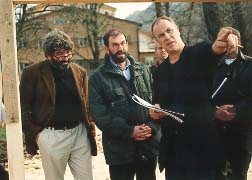
| |
| ROBERT WILSON POINTS OUT "STATIONS" SITE--American artist and theatre-innovator Wilson [right] consults with Oberammergau leaders Otto Huber and Bürgermeister Fend. Photo: Achim Bunz/©Oberammergau 2000. | |
Inspired by—but not remotely resembling—the 14 Roman Catholic Stations of the Cross, it consists of six small wooden houses with displays inside, plus two larger symbolic Stations. Only one person at a time can look inside the houses and hear the music and sound-effects Wilson has devised for each symbolic scene.
In one house are two files of Shaker women knitting. St. Veronica wiping Jesus' sweat with her handkerchief is represented in another house by a Shaker woman holding a flat-iron.
In yet another, there are raging red wolves backed by the Alps. This represents Jesus' agony on the Cross.
Fortunately, there is a brochure explaining the correspondences. Old-time Oberammergauers weren't too pleased with this creation, but it was rather hidden behind the theatre. It is scheduled to tour, unlike the actual Passion Play.
For those who missed both the play and the Stations, Munich's Prestel Verlag has published very handsome books on both, lavishly illustrated. There's even a children's version of the drama of the Passion Play!
In addition, there's a CD of Rochus Dedler's music for the Passion Play. And sets of color postcards of scenes from the drama. As well as sets of color-slides, one of which totals 36 images!
Those who want to check out possible instances of anti-semitism can obtain the actual Passion Play textbook. It is published in two versions. One is in German, but when you turn it over, the English version is in the back. The second version does the same with French and Spanish.
If you want to know more about Oberammergau and its famed Passion Play—or purchase any of the items above—try the website: www.passionspiele2000.de
[Loney]
Copyright © Glenn Loney 2000. No re-publication or broadcast use without proper credit of authorship. Suggested credit line: "Glenn Loney, New York Theatre Wire." Reproduction rights please contact: jslaff@nytheatre-wire.com.
| home |
listings |
columnists |
reviews |
what's new? |
cue-to-cue |
people |
welcome |
| museums |
recordings |
what's cool? |
who's hot? |
coupons |
publications |
classified |